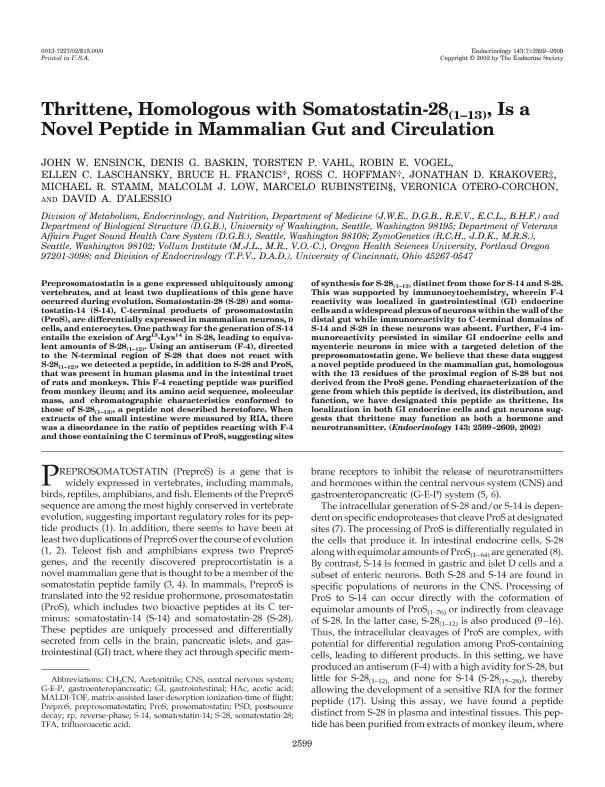Artículo
Thrittene, homologous with somatostatin-28(1-13), is a novel peptide in mammalian gut and circulation
Ensinck, John W.; Baskin, Denis G.; Vahl, Torsten P.; Vogel, Robin E.; Laschansky, Ellen C.; Francis, Bruce H.; Hoffman, Ross C.; Krakover, Jonathan D.; Stamm, Michael R.; Low, Malcolm J.; Rubinstein, Marcelo ; Otero Corchon, Veronica; D'Alessio, David A.
; Otero Corchon, Veronica; D'Alessio, David A.
 ; Otero Corchon, Veronica; D'Alessio, David A.
; Otero Corchon, Veronica; D'Alessio, David A.
Fecha de publicación:
07/2002
Editorial:
Oxford University Press
Revista:
Endocrinology
ISSN:
0013-7227
Idioma:
Inglés
Tipo de recurso:
Artículo publicado
Clasificación temática:
Resumen
Preprosomatostatin is a gene expressed ubiquitously among vertebrates, and at least two duplications of this gene have occurred during evolution. Somatostatin-28 (S-28) and somatostatin-14 (S-14), C-terminal products of prosomatostatin (ProS), are differentially expressed in mammalian neurons, D cells, and enterocytes. One pathway for the generation of S-14 entails the excision of Arg13-Lys14 in S-28, leading to equivalent amounts of S-28(1-12). Using an antiserum (F-4), directed to the N-terminal region of S-28 that does not react with S-28(1-12), we detected a peptide, in addition to S-28 and ProS, that was present in human plasma and in the intestinal tract of rats and monkeys. This F-4 reacting peptide was purified from monkey ileum; and its amino acid sequence, molecular mass, and chromatographic characteristics conformed to those of S-28(1-13), a peptide not described heretofore. When extracts of the small intestine were measured by RIA, there was a discordance in the ratio of peptides reacting with F-4 and those containing the C terminus of ProS, suggesting sites of synthesis for S-28(1-13) distinct from those for S-14 and S-28. This was supported by immunocytochemistry, wherein F-4 reactivity was localized in gastrointestinal (GI) endocrine cells and a widespread plexus of neurons within the wall of the distal gut while immunoreactivity to C-terminal domains of S-14 and S-28 in these neurons was absent. Further, F-4 immunoreactivity persisted in similar GI endocrine cells and myenteric neurons in mice with a targeted deletion of the preprosomatostatin gene. We believe that these data suggest a novel peptide produced in the mammalian gut, homologous with the 13 residues of the proximal region of S-28 but not derived from the Pros gene. Pending characterization of the gene from which this peptide is derived, its distribution, and function, we have designated this peptide as thrittene. Its localization in both GI endocrine cells and gut neurons suggests that thrittene may function as both a hormone and neurotransmitter.
Palabras clave:
Somatostatina
Archivos asociados
Licencia
Identificadores
Colecciones
Articulos(INGEBI)
Articulos de INST.DE INVEST.EN ING.GENETICA Y BIOL.MOLECULAR "DR. HECTOR N TORRES"
Articulos de INST.DE INVEST.EN ING.GENETICA Y BIOL.MOLECULAR "DR. HECTOR N TORRES"
Citación
Ensinck, John W.; Baskin, Denis G.; Vahl, Torsten P.; Vogel, Robin E.; Laschansky, Ellen C.; et al.; Thrittene, homologous with somatostatin-28(1-13), is a novel peptide in mammalian gut and circulation; Oxford University Press; Endocrinology; 143; 7; 7-2002; 2599-2609
Compartir
Altmétricas



